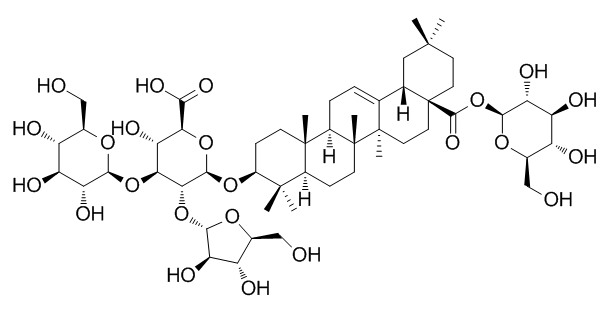Schefflera leucantha
Schefflera leucantha
1. The products in our compound library are selected from thousands of unique natural products; 2. It has the characteristics of diverse structure, diverse sources and wide coverage of activities; 3. Provide information on the activity of products from major journals, patents and research reports around the world, providing theoretical direction and research basis for further research and screening; 4. Free combination according to the type, source, target and disease of natural product; 5. The compound powder is placed in a covered tube and then discharged into a 10 x 10 cryostat; 6. Transport in ice pack or dry ice pack. Please store it at -20 °C as soon as possible after receiving the product, and use it as soon as possible after opening.
Natural products/compounds from Schefflera leucantha
- Cat.No. Product Name CAS Number COA
-
BCN8806
Kalopanaxsaponin G171370-50-6
Instructions

Inhibitory effects of Schefflera leucantha extract on production of allergic mediators by Langerhans cells and mast cells.[Pubmed: 21243929]
Schefflera leucantha Viguier is used as a traditional medicine in Thailand and China to relieve chronic cough and asthma. However, little is known about its anti-allergic effects.
Biological activities of Schefflera leucantha.[Pubmed: 20162087]
This study investigated various biological activities of the ethanolic extract of dried ground leaves of Schefflera leucantha Viguier (Araliaceae). The extract possessed very low cytotoxicity to brine-shrimp with the LC(50) of 4,111.15 microg/ml; the significant antioxidant activity on DPPH with the EC(50) of 71.90 microg/ml; the inhibitory activity on mushroom tyrosinase with the IC(50) of 10.53 mg/ml using the dopachrome microplate-assay. The extract of 5-20 mg/ml range in the agar dilution assay were active against various pathogenic microbial (11 species, 11 strains), with the minimum inhibitory concentration (MIC) of 5 mg/ml against Clostridium spp.; MIC=10 mg/ml against enteropathogens as Bacteroides spp., Enterococcus faecalis ATCC 29212, Lactobacillus spp., Peptococcus spp. and Streptococcus mutans; MIC=10 mg/ml against a pneumonia causing bacteria Klebsiella pneumoniae and a dermatopathogen as Propionibacterium acnes; MIC=20 mg/ml against dermatopathogens as Staphylococcus aureus ATCC 6538, Streptococcus spp. and Candida albicans ATCC 90028. TLC fingerprints of the specific extracts from the leaf powder exhibited zones of steroids-terpenes and flavonoids. HPLC fingerprint of the flavonoid extract was performed.
Acute and subacute toxicities of the saponin mixture isolated from Schefflera leucantha Viguier.[Pubmed: 14522442]
Acute toxicity of the bronchodilator saponin mixture isolated from Schefflera leucantha Viguier leaves was investigated in comparison with the methanol and the water extract of this plant. Oral doses of 5000 mg/kg of the methanol extract, the water extract and the saponin mixture did not produce mortality or significant changes in the general behavior and gross appearance of internal organs of rats. Subacute toxicity of the saponin mixture was evaluated with the dose of 1000 mg/kg, orally for 14 days. An extra group (satellite group) was given saponin mixture and kept for a further 14 days after treatment. All animals did not show signs of toxicity during the experimental period. Liver weights of the saponin-treated and the satellite male groups were higher whereas testis weight were lower than those of the control group which received distilled water. However, the histological examination of various organs revealed that there were no differences between the control and the treated rats. BUN, Cr, AST, ALT and ALP levels increased in saponin-receiving rats. It is possible that the saponin mixture directly impacts on the liver and the kidney functions.


